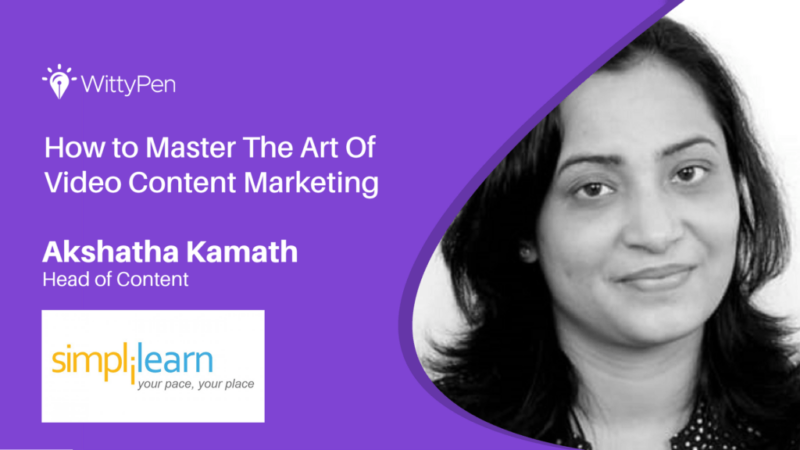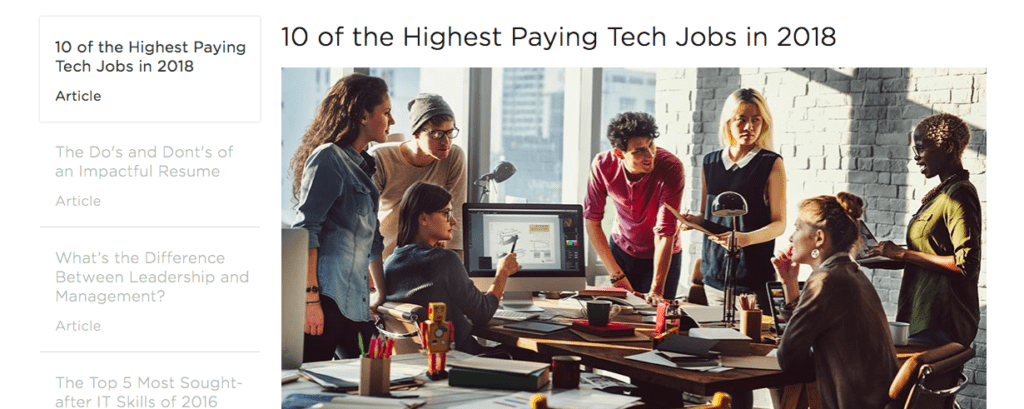Last updated on January 11th, 2022
Video content marketing is becoming popular with each passing day and is the current favourite for so many marketers. Content marketers are able to achieve versatility and virality of their content through different types of videos for marketing.
In this blog, Akshatha Kamath who heads Content Marketing at Simplilearn talks about the importance of video content marketing. But before we go on to that, let’s learn a little about Akshatha and Simplilearn.
About Akshatha
Akshatha Kamath is the Head of Content at Simplilearn. She is a content marketing specialist with close to 12 years of experience in writing, strategizing and managing content for various organizations.
Before Simplilearn, she’s worked with companies like Vizury and Conzerv (now part of Schneider, India) helping them with content, brand and communication strategies that are aligned with the business goals and brand recall for the digital space.
She is an avid reader and a traveller who enjoys experiencing the flavors of life from different places. You can check out Akshatha’s social networks here:Twitter Handle,LinkedIn Account
About Simplilearn
Simplilearn enables professionals and enterprises to succeed in the fast-changing digital economy. The company provides outcome based online training across digital technologies and applications such as Big Data, Machine Learning, AI, Cloud Computing, Cyber Security, Digital Marketing and other emerging technologies.
Based in San Francisco, CA, Raleigh, NC and Bangalore, India, Simplilearn has helped more than one million learners and 1000+ companies across 150+ countries get trained, acquire certifications and reach their business and career goals.
The company’s high-engagement curriculum blends self-paced online learning, instructor-led live virtual classrooms, hands-on projects, student collaboration, and 24/7 global teaching assistants. Simplilearn is recognized by Training Industry as a Top 20 IT Training Company for 2017.
What’s the role of videos in content marketing?
There are various reasons why videos are strategically important to your content mix, now more than ever. Videos are the highest consumed content format today. According to Buffer, More than 500 million hours of videos are watched on YouTube every day.
On social media, videos can help you reach as much as 300% more users and drive upto 150% more engagement. Also, traditional formats such as blogs that contain video content will see a lift in SEO. Videos are more powerful in capturing user attention and keeping them hooked, especially on mobile.
To sum it all up, video content marketing can help you grow your reach, engagement and the overall marketing ROI.
Check out Simplilearn’s Blog with an embedded video. To know how to embed videos in our blog, click here.
Why is repurposing important?
As content marketers, we mostly strive to create rich and original content that is meaningful to our audience. To create impactful and evergreen content you’ll need to go through the stages of research, topic definition, writing, editing and then distribution – which means, you’ll invest time and sometimes marketing dollars.
But when you repurpose content, you start with one good idea/theme and then expand that into a different angle or other content formats such as blogs, videos, infographics, slideshare, podcast the list can go on. A strong content repurposing strategy will help you lower costs, reach a wider audience, and extend the longevity of your content piece.
Repurposing videos and articles from one to the other are popular content marketing practices that work well with the audiences. For example, if you’ve repurposed a blog into a video and then hosted this video on your YouTube channel, you’re doing two things. Firstly, your YouTube users might be different from your blog users, but they will still be similar in demographics. So you’re taking this great piece of content that you’ve created and reaching another set of users who might find this helpful.
Next, you can embed the video within the article after the first fold. So anyone on the blog who doesn’t want to spend time reading can consume the video content and this will help you increase the average time-on-page for your blogs.
Who do you target with repurposed content?
If the underlying theme of the original and re-purposed content are same (which is usually the case), the audience demographic remains similar, but their stage in the buyer’s journey might change.
For example, let’s say you have an eBook about advanced mobile marketing tips with the original intent of engagement and lead generation. You will be able to repurpose the report and pull-out micro-graphics, blogs, teasers that map out across awareness, engagement and conversion stages.
How frequently should a brand produce videos?
As much as you need to. Videos work best for top-of-the funnel engagement and based on your marketing goals and audience you need to carefully weave in videos into your marketing mix. Create a pipeline of videos and do focus on the quality of content and the experience within your videos. Ensure that you have an engaging narrative and most importantly, a story to tell.
Here are some videos by Simplilearn
How should you distribute your videos?
A great video distribution strategy will cover all your major channels such as email, social media, website, blog, YouTube, Slideshare, partner blogs, sales assets, press releases and more. Another interesting use case to repurpose videos is to use a video still and pin it to your Pinterest handle. The key, however, is to reach out to the right audience and use contextual videos across your buyer’s journey.
What tools do you recommend to create/repurpose videos?
Not all content marketers are video editing experts. But tools such a Lumen 5, Rocketium have simplified video production. With these tools you can create highly engaging videos that can be used across your website, YouTube or social media. You can use Animaker, VideoScribe to create animated or whiteboard content. But you’ll need some more time and design skills to build these videos.
Do you promote your videos or do you rely on their organic growth?
Both are important. If you have good content, you’ll see higher engagement and traffic. But why shy away from promoting it? Organic reach is typical to users who have already consumed your content in the past or are searching for a related topic – these are users who are viewing your videos because they want to.
But with paid promotions, especially on your social networks, you’ll be able to reach out to new but relevant users. In the case of B2B companies, videos can be used for account-based marketing via paid social ads.
Promotional Ad by Simplilearn.
Any video content marketing initiatives that are running currently and previous campaigns that you would like to share?
Yes, there are two ways in which we’ve leveraged videos in our your content marketing campaigns at Simplilearn.
- Video teasers on social media: We’ve implemented video marketing for our blog and webinar promotions across various marketing channels and this has helped us expand our audience size and also keep them hooked for a longer duration when compared with banner posts. Here’s an example.
- Video to blog repurposing: Repurposing helps us reach our audiences across our blog and YouTube with engaging content. Here’s an example of a video to blog conversion.
The article above is repurposed into a video that you can see below.
Tips for content marketers
Understand your buyer personas and create targeted videos that solve a problem for your customer. Similar to blog content, follow the 90-10 rule (The first 90% of your video should talk about the user’s problem and a likely solution.
The last 10% can be reserved to talk about how your offering can help the user.) Focus on the overall experience and the narrative. Choose the most effective way to tell your story. For example, explainer videos are best described with screen grabs and whiteboarding techniques, teaser videos can be stock-heavy, choose talking head videos for influencer content and so on. But above all, tell a story that the user wants to hear.
To Sum Up
The growing need for video content -whether it’s a short or long, animated or love, scripted or real has increased. Human beings are more prone to interacting with visuals as opposed to text.
Since visual content is at it’s highest peak, is easy to create and is highly engaging, content marketers should invest more time and efforts in aligning their content strategy with video marketing.
Acknowledgement
We would like to heartily thank Akshatha for taking out the time to answer our questions. These insights on video content marketing are very beneficial and would surely help many individuals and brand take a positive stride.










